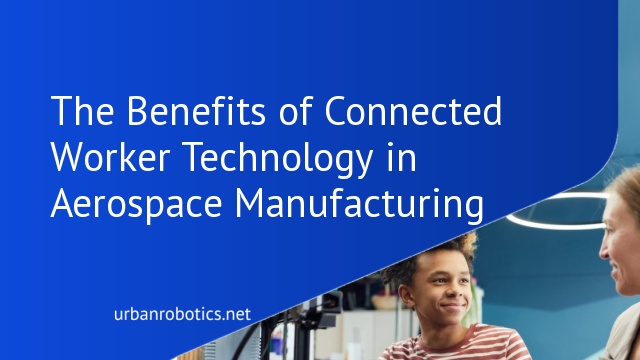Discover the benefits of connected worker technology in aerospace manufacturing and how it can improve productivity and efficiency.
Connected worker technology is revolutionizing the world of aerospace manufacturing by constructing integrated working environments that improve both collaboration and data management. In these connected workplaces, humans and machines seamlessly interact through digital devices, resulting in significantly efficient operations and communication flow.
The remarkable part about connected worker technology is that it doesn’t just maneuver in one area. It spans across multiple areas – from swift data transfer speeds to quick access to information and training materials, all the way to ensuring up-to-date safety information is accessible at the frontline. The technology integrates seamlessly among production, maintenance, reporting, managing logistics, and upskilling staff.
According to industry standards, the projected market value of the connected worker technology industry is expected to reach $23.2 billion by 2029. This speaks volumes about the increasingly significant role connected worker technology is playing in Industry 4.0. The aerospace manufacturing sector, being one of the key areas, is fast heading towards becoming the factory of the future by using advanced technology such as the Internet of Things (IoT) and automation.
Let us unfurl the incredible benefits that connected worker technology brings to aerospace manufacturing.
Benefits of Connected Worker Technology
Connected worker technology can be seen as a pillar of growth and efficiency in aerospace manufacturing. It is progressively changing the dynamics of the traditional manufacturing process by majorly integrating and digitizing operations — transforming from paper-based workflows to digital, connected ones.
The benefits of adopting connected worker technology in aerospace manufacturing are:
- Enhanced Visibility and Communication: Connected worker technology bridges the communication gap between teams, fostering better collaboration and making the flow of information flawless. It offers real-time data visibility to the employees across all levels, allowing quicker decisions based on the digitization of knowledge.
- Greater Productivity and Efficiency: With paperwork reduction, process automation, and mobility at work, connected worker technology enhances work efficiency. It aids in capacity planning, measuring productivity levels, and collecting feedback in real-time, ensuring that the turnaround time is drastically reduced and productivity is significantly increased.
- Error-Proofing: With features such as routine reporting and adherence monitoring, connected worker technology ensures zero defects in production. Automated error checking and guidance can drastically improve product quality, providing greater peace of mind to managers and operators alike.
- Equipping the Frontline: Connected worker technology empowers operators with quick access to technical information and advanced tools. It gives the frontline staff the ability to address deviations faster and maintain a high standard of product quality, thereby leading to a happier customer base.
- Safety Compliance & Training: The technology can provide real-time safety compliance checks and immersive, job-specific training to improve safety and upskill the employees, making them well-prepared to handle sophisticated equipment. With tailored training materials accessible through the connected worker platform, upskilling the workforce is more effective than ever.
Zaptic: A Leading Connected Worker Platform
Zaptic is a stalwart when it comes to advanced platforms that facilitate a connected workplace. Essentially, it is a connected worker platform that is laser-focused on job instruction and collaboration for frontline teams. Zaptic effectively bridges gaps between the traditional and digital operations, bringing about an accelerated transformation in the process.
The salient features of Zaptic are:
- Optimizing Operations and Asset Care: Zaptic provides real-time data access to the team. With quick data transfer and increased visibility, it becomes easier for the team to make timely decisions. This eventually leads to optimized operations and improved care for assets.
- Safer Workplace: With Zaptic, maintaining safety standards is no longer a chore. The platform provides immediate access to safety information to all workers. It aids in maintaining compliance to safety guidelines, ultimately creating a safer workplace.
- Maximized Machine Maintenance: Zaptic facilitates preventative and predictive maintenance of machines. The data collected from different machines can be used to monitor their health, predict failures, and schedule maintenance, reducing machine downtime.
- Job-Specific Training: Zaptic comes packed with training modules that are curated for specific jobs. This makes training more targeted and effective.
Zaptic makes the benefits of a connected workplace accessible to companies delving into digital transformation, becoming the backbone of the enhanced visibility, communication, error-proofing, efficiency, and decision-making in the connected worker landscape.
The Impact of Connected Worker Technology on Aerospace Manufacturing
The impact of connected worker technology on aerospace manufacturing is notable. The technology, with its capabilities of process automation and data standardization, prompts a restructuring of the old ways, thereby fostering operational resiliency and greater productivity.
Let’s take a quick tour of the tangible effects of this technology:
- Increased OEE (Overall Equipment Effectiveness): By transforming operators into connected workers, the communication, access to equipment knowledge, access to training materials, and real-time information flow are amplified. This results in a decrease in equipment breakdown time and promotes faster resolution of issues. The unwavering commitment to zero defects leads to a significant increase in OEE, a key performance indicator in manufacturing.
- Higher Product Quality: Operators equipped with instant access to technical education and data can detect deviations and resolve issues promptly. This accelerates decision-making and ensures a higher product quality.
- More Significant Safety Measures: With an integrated connected worker platform, safety measures are not just defined but delivered to the frontline worker faster and more efficiently, thus promoting a safer workplace.
- Seamless Knowledge Sharing: The sharing of information, strategies, and progress reports is no longer a substantial task. Connected worker platforms uphold the promise of seamless knowledge sharing, thereby fostering a more profound understanding of information cross-departmentally.
- Increased Upskilling: With training materials and job instructions readily available for quick access, upskilling becomes a continuous process in the manufacturing flow.
Connected worker technology does more than just improving factory operations. It provides a blueprint for the factory of the future combining sophisticated automation capabilities and intelligence to unlock great productivity and profitability.
With this surge in connectivity and data flow, the importance of robust cybersecurity measures cannot be understated. Aerospace manufacturers must ensure the protection of sensitive data and guard against potential cyber threats. In this context, exploring Virtual SOC (Security Operations Center) Solutions is pivotal. These solutions provide comprehensive monitoring and threat detection, ensuring that the advanced technological landscape of aerospace manufacturing remains secure and resilient.
Reflections
The aerospace manufacturing sector stands at the threshold of a significant shift. A shift powered by connected worker technology.
With its ability to enhance visibility, communication, error-proofing, efficiency, and decision-making, connected worker technology is not just improving productivity but also setting new benchmarks for work efficiency in the workforce and manufacturing equipment.
Investing in connected worker technology will usher aerospace manufacturers into an era of enhanced asset and workforce connectivity, seamless data collection, and advanced data management.
Ultimately, this technology ensures the smooth daily operations of the aviation industry, from enhancing job-specific training and fostering knowledge-sharing to error-proofing routine tasks and promoting a safer workplace. In essence, the journey with connected worker technology is a journey towards industry 4.0, the factory of the future.
So, the question isn’t about whether the aerospace industry should adopt connected worker technology, but about how quickly it can adapt and transform. And it starts with finding the right connected worker technology partner for your manufacturing needs.
After all, in an industry where precision and perfection are paramount, Industry 4.0 technologies like the connected worker have a major role to play. The future of aerospace manufacturing is digital, connected, and undeniably exciting. Join the team and empower the people who carry the world.





